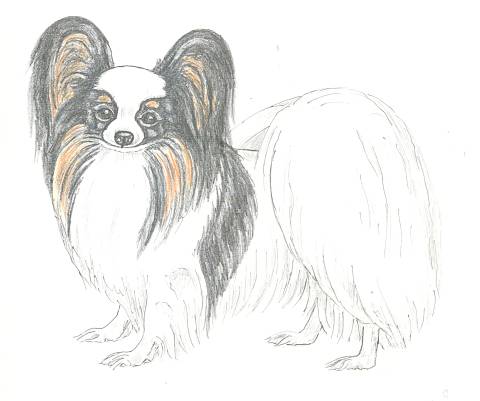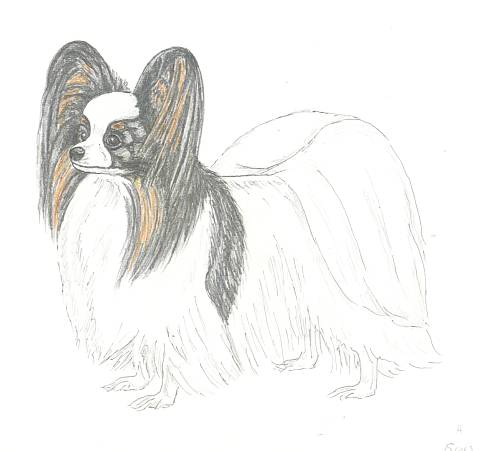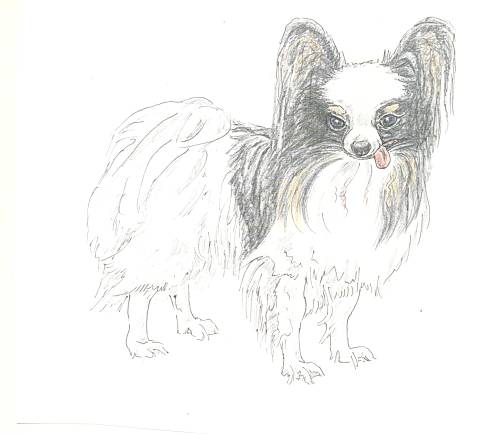

| ©2005 Ms D E Ashdown |
| (You are not permitted to copy any illustrations from this site - please note copyright warning on Home Page) |
|
THE STANDARD AND AGE |
|
|
No Breed Standard concerns itself with
taking age into account when judging; this is left to the wisdom and
common sense of the Judge of the day. Nevertheless in as detailed and
comprehensive a work as the CISPAP some space needs to be devoted to the
Papillon and Phalene at various stages of development and maturity. As an indicator of the contents for this section of the Book, here is a sequence of 10 drawings showing the development and characteristics of a papillon from 4 weeks to 18 years. Note that the sequence is not intended to depict either every individual dog as it grows and matures, just this example, and it is intended to depict typical characteristics in a breed which is after all generally slow maturing, and in which puppies and young dogs can change very radically, sometimes is a short space of time!! We have called him "Mercury" - mercury being a substance noted for changing its shape!!!! Of course not all papillons develop at the same rate, some develop much more quickly (sometimes surprisingly so!!!) some take longer but this sequence is based on the development of an 'average' papillon. |
|
 |
 |
| A | B |
| Drawing A shows a puppy at 4 weeks. Note the good stop, short muzzle, eye placement and large ears. At 10 weeks (B) Mercury shows clearly his length of body to height, sweet expression, good dark eye and good well placed ears. At this age the tan is typically pale. The set of tail is high - something that usually will change with age. | |
 |
 |
| C | D |
| At 4 months (C) the head is looking a little plainer and chunkier, proportions remain good. At 7 months (D) Mercury is well into the "awkward stage" which in some papillons can last an agony of time. Tan is deepening and brightening as is the contract with the black colouring. Fringes are starting to develop, bone is fining down nicely. He looks rather leggy at this stage accentuated by not having dropped in brisket. He also looks rather "nosey". | |
 |
 |
| E | F |
| E shows Mercury at 13 months, he is beginning to resemble the dog he will become at maturity. Coat silky, flat and developing but still a little raggy. Chest and Body fringes still rather sparse, skull and muzzle now in better proportion. At 18 months (F) Mercury presents an more finished picture. Note that he still lacks chin. His broad and perhaps flattering blaze is evening out, he is developing a good ruff and a full tail plume | |
 |
 |
| G | H |
| Mercury is shown at the age of 3 years in G. This shows him in full coat and glorious ear fringing. He has developed a good chin to balance his muzzle and skull; also tufts to his hare feet. At the age of 6 (H) Mercury is perhaps at the height of his maturity and in full bloom. He has a huge but flat and silky coat. A good quality slow maturing Papillon is often at his peak at this age. For some he may have too much coat, obscuring his outline somewhat, and making him appear a little long. But this it would seem is the modern show coat. | |
 |
 |
| I | J |
| At the age of 12 (I) Mercury can be shown as a Senior Veteran. He is still in lovely shape though is rather a little heavier in shoulder now and does not seem to have quite the coat he once possessed. He is showing some frosting on the face and his very dark eyes are beginning to lose a little of their colour. Feet are beginning to spread a little, but still Mercury looks magnificent for his age. He can be expected to have lost a few teeth by now, altering the shape of his muzzle. The tan is not quite as vivid as it once was. At the age of 18 (J) all the conditions associated with extreme old age in the dog can be expected to have set in. His leg's and feet, which have been keeping him up for 18 years, are showing the strain, and his front is not quite what it once was. His eyes are bluish indicating old age cataracts, though he can still see well enough. He may be rather deaf now - particularly when he wants to be!!! He has lost a good deal of coat, pigmentation and fringing to the ears, but ear carriage and basic fringe quality can still be seen. His tail is carried much flatter now, a process which was beginning to show itself in I. Mercury has lost most of his teeth making it difficult for him to hold his tongue in. The loss of teeth also affects his muzzle which is now even finer and smaller than it was when he was being exhibited. He has lost weight, as the old body will not absorb food as readily as once it did, even though he still enjoys his food and eats well. Still, at 18, a handsome old healthy dog showing many of the features of his former years. He will not be troubled by journeys to shows and can enjoy his well earned retirement. It is quite possible that we will see him pottering around the garden for a couple of more years yet. | |